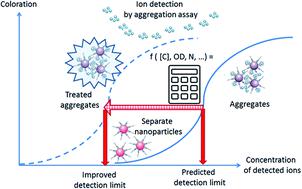当前位置:
X-MOL 学术
›
Anal. Methods
›
论文详情
Our official English website, www.x-mol.net, welcomes your
feedback! (Note: you will need to create a separate account there.)
Limitations for colorimetric aggregation assay of metal ions and ways of their overcoming
Analytical Methods ( IF 2.7 ) Pub Date : 2020-12-11 , DOI: 10.1039/d0ay02068k Anna N. Berlina 1, 2, 3, 4 , Dmitry V. Sotnikov 1, 2, 3, 4 , Nadezhda S. Komova 1, 2, 3, 4 , Anatoly V. Zherdev 1, 2, 3, 4 , Boris B. Dzantiev 1, 2, 3, 4
Analytical Methods ( IF 2.7 ) Pub Date : 2020-12-11 , DOI: 10.1039/d0ay02068k Anna N. Berlina 1, 2, 3, 4 , Dmitry V. Sotnikov 1, 2, 3, 4 , Nadezhda S. Komova 1, 2, 3, 4 , Anatoly V. Zherdev 1, 2, 3, 4 , Boris B. Dzantiev 1, 2, 3, 4
Affiliation

|
The development of analytical methods for the determination of metal ions in water is one of the priority tasks for efficient environmental monitoring. The use of modified gold nanoparticles and the colorimetric detection of their aggregation initiated by ions binding with specific receptors on the nanoparticle surface has high potential for simple testing. However, the limits of this approach and the parameters determining the assay sensitivity are not clear, and the possibilities of different assay formats are estimated only empirically. We have proposed a mathematical description of the aggregation processes in the assay and have estimated the detection limits of an aptamer-based assay of Pb2+ ions theoretically and experimentally. In the studied assay, gold nanoparticles modified with G,T-enriched aptamer were used, and their aggregation caused by the interaction with Pb2+ ions was controlled via a color change. The experimentally determined limit of Pb2+ detection was 700 ppb, which was in good agreement with theoretical calculations. An examination of the model showed that the limiting parameter of the assay is the binding constant of the aptamer–Pb2+ ion interaction. To overcome this limitation without searching for alternate receptors, two methods have been proposed, namely additional aggregation-causing components or centrifugation. These approaches lowered the detection limit to 150 ppb and even to 0.4 ppb. The second value accords with regulatory demands for the permissible levels of water source contamination, and the corresponding approach has significant competitive potential due to its rapidity, simple implementation, and the visual assessment of the assay results.
中文翻译:

金属离子比色聚集试验的局限性及其克服方法
开发用于测定水中金属离子的分析方法是高效环境监测的优先任务之一。修饰金纳米颗粒的使用以及比色检测由与纳米颗粒表面上的特定受体结合的离子引发的聚集,具有进行简单测试的巨大潜力。但是,这种方法的局限性和确定测定灵敏度的参数尚不清楚,并且仅凭经验估算不同测定形式的可能性。我们提出了测定中聚集过程的数学描述,并估计了基于适体的Pb 2+测定的检测限离子在理论上和实验上。在研究的测定中,使用了富含G,T的适体修饰的金纳米颗粒,并通过颜色变化控制了与Pb 2+离子相互作用引起的聚集。实验确定的Pb 2+检出限为700 ppb,与理论计算值非常吻合。对模型的检查表明,测定的极限参数是适体– Pb 2+的结合常数离子相互作用。为了克服该限制而不寻找替代受体,已经提出了两种方法,即另外的引起聚集的组分或离心。这些方法将检测极限降低到150 ppb,甚至降低到0.4 ppb。第二个值符合监管机构对允许的水源污染水平的要求,并且相应的方法具有快速,易于实施和对检测结果进行直观评估的优势,因此具有很大的竞争潜力。
更新日期:2020-12-23
中文翻译:

金属离子比色聚集试验的局限性及其克服方法
开发用于测定水中金属离子的分析方法是高效环境监测的优先任务之一。修饰金纳米颗粒的使用以及比色检测由与纳米颗粒表面上的特定受体结合的离子引发的聚集,具有进行简单测试的巨大潜力。但是,这种方法的局限性和确定测定灵敏度的参数尚不清楚,并且仅凭经验估算不同测定形式的可能性。我们提出了测定中聚集过程的数学描述,并估计了基于适体的Pb 2+测定的检测限离子在理论上和实验上。在研究的测定中,使用了富含G,T的适体修饰的金纳米颗粒,并通过颜色变化控制了与Pb 2+离子相互作用引起的聚集。实验确定的Pb 2+检出限为700 ppb,与理论计算值非常吻合。对模型的检查表明,测定的极限参数是适体– Pb 2+的结合常数离子相互作用。为了克服该限制而不寻找替代受体,已经提出了两种方法,即另外的引起聚集的组分或离心。这些方法将检测极限降低到150 ppb,甚至降低到0.4 ppb。第二个值符合监管机构对允许的水源污染水平的要求,并且相应的方法具有快速,易于实施和对检测结果进行直观评估的优势,因此具有很大的竞争潜力。











































 京公网安备 11010802027423号
京公网安备 11010802027423号